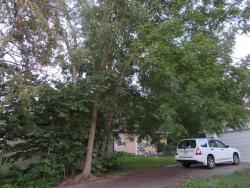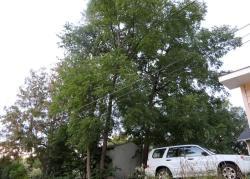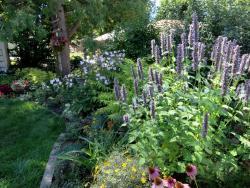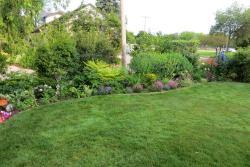When I moved to my present home many years ago, there were some small black walnut trees in the southwestern corner of the yard. At that time, I had no idea what they were, and I certainly knew nothing about the allelopathy, or toxicity of juglone to certain plants. I did not start gardening until many years later. The very first perennial bed I put in was within the root zone of these trees, in deep shade and also under a large double-trunked cedar tree. I happily and obliviously planted whatever I wanted. By pure dumb luck, everything I planted was juglone-tolerant.
As we all know, gardening is a process and a learning experience. I can’t recall exactly when I realized that the trees were black walnut trees, or when I learned about juglone. But now I know, and when planting near the trees I first try to determine whether the plants are juglone tolerant. It is a frustrating process. There is disagreement from list to list as to which plants will work, and none of the lists I have found is very extensive. The good news is that over time I have found many more plants than I expected that will grow near black walnuts. So far I have found only a few plants that absolutely will not grow in or near the root zone or dripline: tomatoes, anise hyssop, baptisia, rodgersia, and yellow wax bells. I saw signs of intolerance with Cheyenne Spirit and Sombrero echinacea this summer, though many of the published lists indicate that coneflowers should tolerate juglone. I suspect that the species and older hybrids might do better; I will test that theory next summer. Just another example of confusing info on this subject.
There are different guidelines as to how far the toxicity extends, but most commonly stated is 2-3 times the distance from the trunk to the outer edge of the canopy. Since these trees get quite large, that can be a lot of real estate. Mature black walnut trees commonly grow to 50-75 feet tall and equally wide, but they can grow to 150 feet tall. My yard is a city lot-and-a-half, so I figure that means at least half, or maybe more, of my entire lot. Then there is the issue of the leaf litter and nuts that go everywhere. I try to keep that cleaned out of my gardens as much as possible. I also do not compost the leaves, though much of the published advice says you can use them without adverse effects. The only thing to do, really, is to decide what you want to plant, look at whatever information you can find, and then go ahead and try it. I am able to recognize the signs of significant intolerance usually within a week or so. In those cases I have had a pretty good success rate if I immediately dig up the plant, spray off all the soil, wash the plant, including the roots, and replant it elsewhere. Some plants do not obviously wilt or die, but they don't thrive either. I place baptisia and columbine in that category.
Despite the fact that I have failed to find an all-knowing oracle of juglone-tolerant plants, the gardens near my black walnut trees are fairly diverse. I still have the original perennial bed, which is now extended northward almost to the street, and garden beds all along the south side of the house. The photos below show the trees and the original expanded border, but not yet the south side of the house. That was just revised this year and is not yet photo-worthy.
So, to get on with my also-imperfect-incomplete list, my walnut trees are located at the southwestern edge of my yard, For the purposes of this article, I am only listing plants that grow in the western half of my yard, and I have included only perennials, trees, and shrubs. Those marked with an asterisk are most likely within the root zone/dripline (I am not sure exactly how far that extends). Please pardon my mixture of botanical and common names. I tend to go with what I can remember and spell!
Perennials:
Achillea*
Amsonia – Blue Ice
Anemone* – anemone sylvestris, grapeleaf anemone, and cutleaf anemone
Anise hyssop/agastache (not juglone tolerant, but I have a couple that are apparently just far enough away; I planted one closer to the trees this summer, and it wilted immediately)
Astrantia*
Baptisia (generally not juglone tolerant, but mine are established and more than 20 feet from the trees)
Bee balm*
Betony – Hummelo
Blue-eyed grass* - Lucerne
Boltonia – Jim Crockett
Brunnera*
Bugbane* (cimicifuga racemosa atropurpurea)
Butterfly weed
Campanula* – Blue Clips and Sarastro
Celandine poppy*
Centranthus ruber
Chrysanthemum
Clematis*
Coreopsis – Early Sunrise, Jethro Tull, Redshift and Zagreb
Cranesbill* – several cultivars
Delphinium – Pagan Purples
Dianthus – Firewitch, Frosty Fire and Heart Attack
Dicentra eximia and spectabilis*
Digitalis lutea*
Digitalis mertonensis*
Ferns*
Geum trifolium/prairie smoke
Goat’s Beard*
Hemerocallis*
Heuchera*
Hosta*
Iris* –crested, Sibirian and bearded
Jack-in-thePulpit*
Joe Pye weed – Gateway
Knautia – Thunder and Lightning
Lady’s Mantle*
Liatris – Floristan White and Kobold
Lilium (generally not juglone tolerant; these are at the far opposite end of my western border garden)
Lobelia siphilitica*
Mayapple*
Ornamental oregano – Herrenhausen
Penstemon – Dark Towers, Prairie Dusk, Rondo Mix
Phlox divaricata* - Blue Moon
Phlox paniculata*
Platycodon* - Fuji Blue and Pink, Sentimental Blue and Pink
Polemonium caeruleum and polemonium reptans*
Primrose* - primrose sieboldii
Pulmonaria * - Raspberry Splash
Rose –Nearly Wild and Flower Carpet Coral
Salvia (perennial) – Caradonna, Eveline, May Night and Rose Queen
Snow on the Mountain/Bishop’s Weed (Aegopodium podagraria ‘Varietaga’)*
Solomon’s seal*
Spiderwort*
Stonecrop* - several cultivars
Tiarella*
Tricyrtis latifolia*
Turtlehead* - white and pink
Veronica – Georgia Blue and Giles Van Hees
Veronicastrum virginicum
Viola *- Etain and Purple Showers
Zizia aurea
Shrubs/trees/vines:
Arborvitae
Barberry*
Burning bush (winged euonymus)
Dogwood – Ivory Halo
Honeysuckle* (Lonicera tatarica)
Hydrangea – Endless Summer, Quickfire and Limelight
Juniper
Lilac (generally not juglone tolerant, but these are established and at least 20 feet from the trees)
Scotch pine – Tannenbaum (not generally tolerant, but might be far enough away to deal with it; just planted a very small one this past summer)
Sumac –Tiger Eyes
Virginia creeper*
Photo showing the tree canopy extending over much of my neighbor's yard:

Photo of the trees looking northward. My west gardens are along the alley on the edge of the yard, extending from the front of the shed almost to the street. In the bottom left corner of the photo, you can see the honeysuckle and lilacs that are part of the garden. The gardens along the back of the house are not visible.

Looking south towards the black walnuts, showing the double-trunked cedar and significant shade. You can see the edge of my garden shed on the left; the black walnut tree trunks are partially visible back from the cedar and are also on the back side of the shed.

Long view of the western border – black walnut trees are to the left of the photo.

| Thread Title | Last Reply | Replies |
|---|---|---|
| The Last Pic by Marilyn | Feb 13, 2022 8:17 PM | 10 |
| Thank you. by crittergarden | Jan 17, 2015 6:23 PM | 5 |